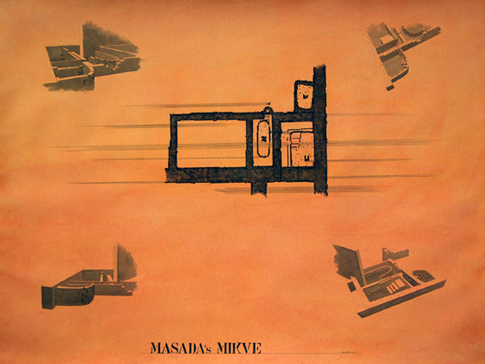
Masada's Mikve, 2008
Mikve denotes both a Jewish ritual of bathing and a bathhouse. Masada is the name of a Jewish fortress on the eponymous mountain in Israel overlooking the Dead Sea. It was built about 40 BC by King Herod and right up to today has played a great role in the history and mythology of Zionist ideology. In his installation, Osvaldo Romberg relocates the foundation walls of the original royal bathhouse by reconstructing them with layers of newspapers. With that, he takes up the ephemerality of the news, which dominates our everyday life and simultaneously demonstrates how, as a collection of wastepaper, it forms the walls of the archive enclosing the cultural space of humanity and transporting it through time.
Osvaldo Romberg, * 1938 in Buenos Aires (RA), lives and works in New York
and Philadelphia (USA)
 Osvaldo Romberg, Masada's Mikve, 2008 Osvaldo Romberg, Masada's Mikve, 2008
drawing, watercolor, 96 x 126 cm
courtesy ZKM | Center for Art and Media Karlsruhe
Osvaldo Romberg
Mikve at Masada, 2008
mixed media installation (stacked newspapers)
courtesy Galerie Heike Curtze Wien-Berlin
produced in Cooperation with ZKM | Center for Art and Media Karlsruhe
|
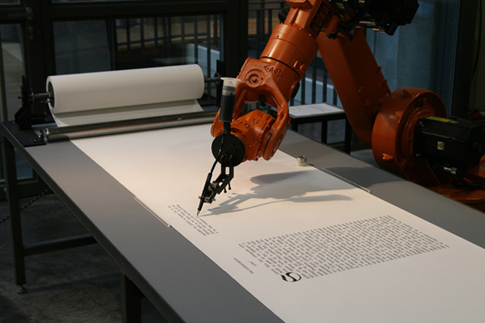
bios [bible], 2007
The artist group robotlab takes up the issue of how people and machines relate: using industrial robots situations are deliberately caused, where the machine performs activities which are usually are subject to human culture. In the installation bios [bible], an industrial robot copies out the Bible in "handwriting." It performs calligraphic precision-work with a quill, like a monk in a monastery's scriptorium. In this way, two fundamentally different systems are related to each other: the formal noting of information and scripture as a basis for religion – scientific rationality and faith. bios [bible] (re)produces the entire Bible in seven months. The rolls of writing are subsequently deposited in the installation's "library."
robotlab
Matthias Gommel, * 1970, Martina Haitz, * 1970, Jan Zappe, * 1969,
live and work in Karlsruhe (D)
 robotlab, bios [bible], 2007 robotlab, bios [bible], 2007
robot installation, dimensions variable
Installation view ZKM | Karlsruhe, 2007
courtesy robotlab
produced in cooperation with
ZKM | Center for Art and Media Karlsruhe
photo: robotlab
With kind support of KUKA, Wintopo, Papier Union, Lamy, Armstrong, Cordier
|
|

Loups et chèvres regardent la vidéo de Aïd-el-Kebir, 2006
Huang Yong Ping's work stands out above all through his subtle interlinking of conceptualising western culture with the traditional, far eastern. The trademark of his mainly sculptural works is in the first instance their large-scale format, yet, on closer inspection, complexity and multi-layering reveals itself, which transports observers into a universe of situations arranged as contradictions. For his Loups et chèvres regardent la vidéo de Aïd-el-Kebir [Wolves and goats watch the video of Aïd-el-Kebir], Ping displays laconic irony in gathering wolves and goats in familiar companionship around a video recording of the traditional celebration of sacrifice (Aïd-el-Kebir), the high point of the Islamic religious year. The "great feast of the lamb" is celebrated in commemoration of the prophet Abraham sacrificing an ewe instead of his son. During Aïd-el-Kebir every family without exception and regardless of whether poor or rich, slaughters an animal.
Huang Yong Ping, * 1954 in Xiamen, Fujian (TJ), lives and works in Paris (F)
 Huang Yong Ping, Loups et chèvres regardent la vidéo de Aïd-el-Kebir, 2006 Huang Yong Ping, Loups et chèvres regardent la vidéo de Aïd-el-Kebir, 2006
mixed media installation (mounted animals, carpets, video)
dimensions variable
courtesy Huang Yong Ping
|
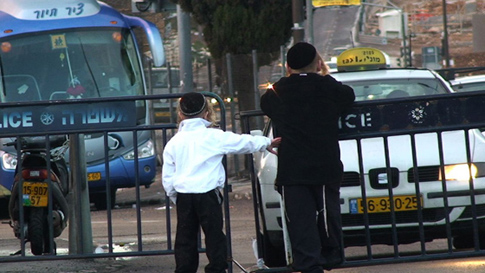
Sabbath 2008, 2008
The work Sabbath 2008 documents the closing of the ultra-orthodox districts in Jerusalem on the eve of the Sabbath. With the consent of police and city administration, residents erect temporary barriers in order to block vehicle access to these areas for 24 hours. During these hours, the strict rules of the religious day of rest apply – topologically, the city is transformed into two cities. Nira Pereg observes this regularly repeated ritual of putting up borders and points to its potential for conflict. Searching for the personal within a systematic ritual, she, in so doing, develops her own photographic and filmic ritual. Out of the presence of the barriers, the portrait of a city emerges, in which sacred space is firmly separated from secular space.
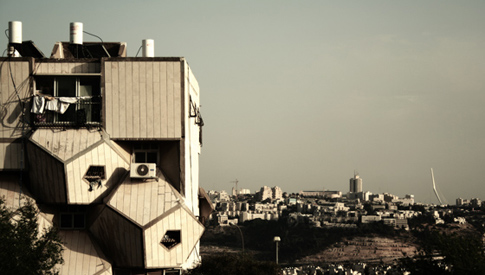
Location 8 – Ramot Polin/Polish Hills, 2008
In Location 8 Nira Pereg resorts to the orthodox neighborhood Ramot Polin, located at the north outskirts of Jerusalem, which has also been a filming location for Sabbath 2008. Built in the 1970s to the designs of Zvi Hecker, one of Israel's most determinedly avant-garde architects, Ramot Polin was one of the few attempts by the national Ministry of Housing, to break out of the standard architectural mold, and create a neighborhood for a religious community. Hecker created a "beehive"-like structure, clattered with almost no straight walls and windows. In her photographs, Pereg focuses the relation between indoor and out door, windows and wall, humans and geometry, and comes up with a story of a place and its inhabitants.
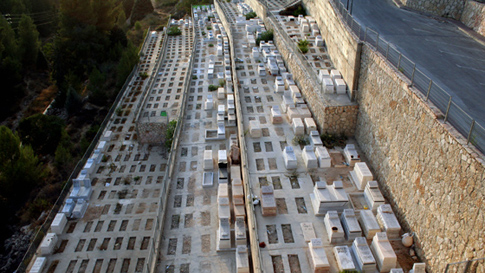
Kept Alive, 2008
The photographs under the title Kept Alive focus on one of the largest cemeteries in Israel, Har Meuchot (Mountain of Rest). This cemetery, founded in 1953, lies on a slope of the mountain along Side Road no. 1, and functions as an impressive backdrop for the main approach road to Jerusalem. The cemetery spreads across 580,000 square meters, and is constantly being expanded. Therefore, it is still possible to reserve burial grounds or to buy them. Reserved graves may be marked at the buyer's request, and a few choose to mark their burial plot with the sign "Alive" or "Kept Alive." In this project, Nira Pereg continues with her search for signs of individuality within a social system, and documents the burial grounds of those who are still living, yet already possess a concrete territory among the dead. By documenting the graves of those who are still alive, but already own a defined bit of territory among the dead, Nira Pereg's work continues her search for signs of individuality within a social system.
Nira Pereg, * 1969 in Tel Aviv (IL), lives and works in Tel Aviv (IL)
 Nira Pereg, Sabbath 2008, 2008 Nira Pereg, Sabbath 2008, 2008
1-channel video projection (colour, sound)
7 min., loop
courtesy Nira Pereg
produced in cooperation with
ZKM | Center for Art and Media Karlsruhe
Nira Pereg, Location 8 – Ramot Polin/Polish Hills, 2008
14 photographs (c-print), each 60 x 80 cm
courtesy Nira Pereg
Nira Pereg, Kept Alive, 2008
12 photographs (c-print), each 70 x 100 cm
courtesy Nira Pereg
|
|



